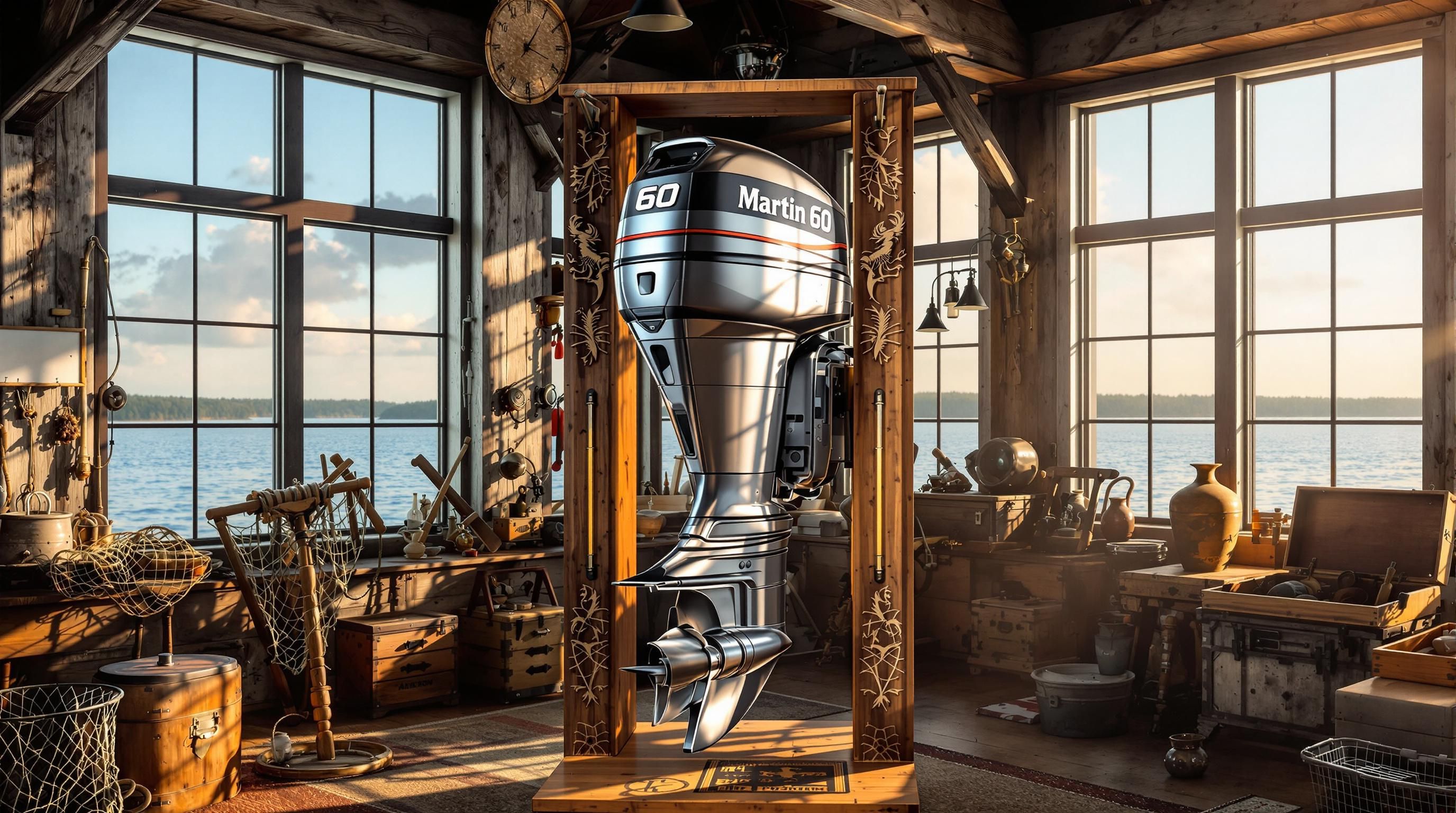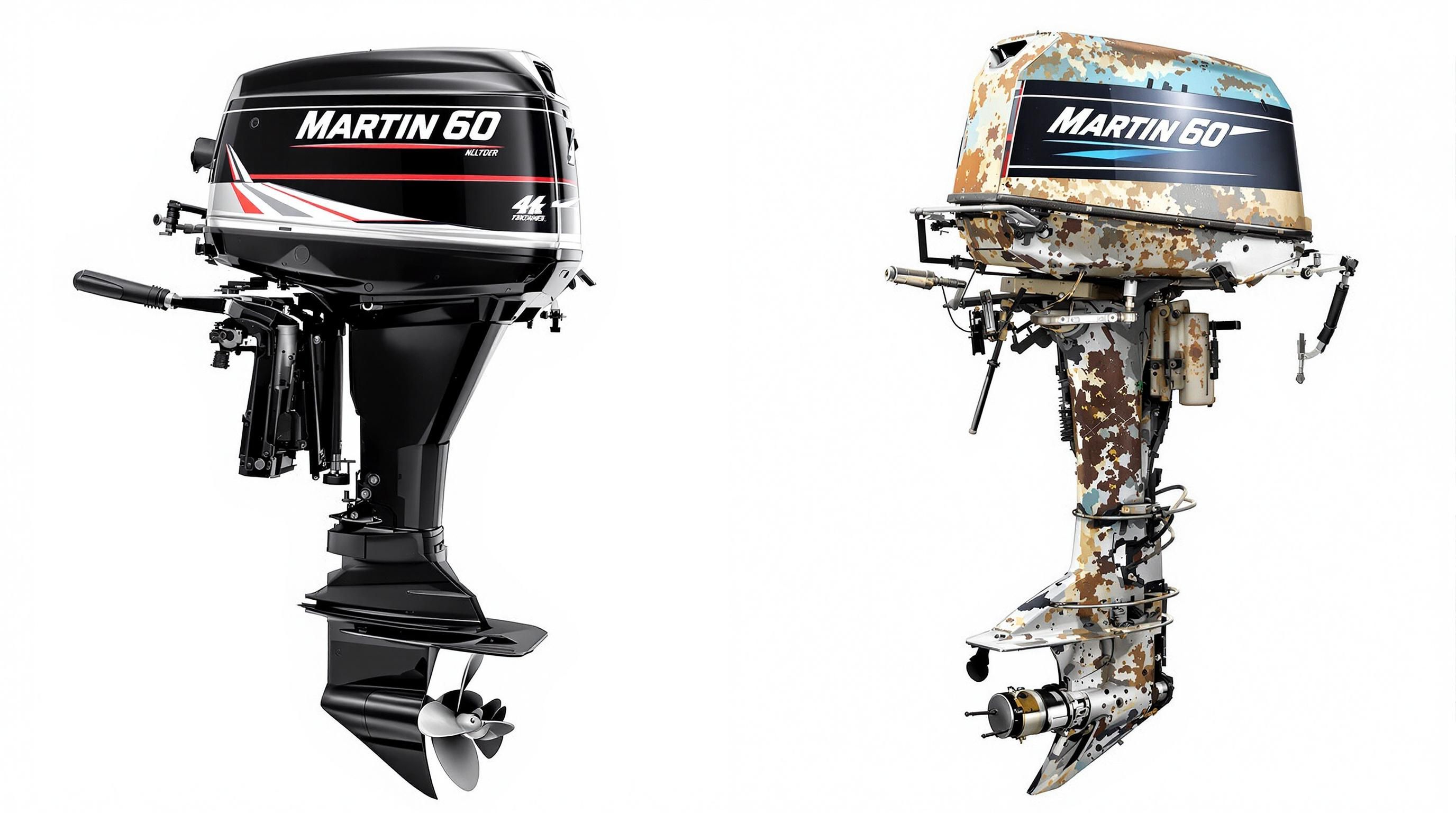Introduction to Martin 60 Outboard Motors
The Martin 60 motor, with its unique “poppet valve” intake system, was advertised as “The New Standard” in boating power. While the brand didn’t survive long in the competitive outboard market, these motors have become sought-after collectibles that represent a distinctive era in American boating innovation.
Martin 60 Value Highlights
Average value for running condition$300-$500+
Excellent restored condition7.2 HP
Standard power rating
Historical Background of Martin Motors
Martin Motors Company History
- 1946
Company Founded
Outboard racer George Martin established Martin Motors, convinced that his "poppet valve" intake method for 2-stroke motors would revolutionize the boating industry. - 1946-1947
Production Agreement
Martin established an unusual royalty-based manufacturing agreement with the National Pressure Cooker Company to produce the motors. - 1947-1948
Martin 60 Introduction
The Martin 60 model was introduced as "The New Standard" in outboard motors, featuring 7.2 horsepower and innovative design elements. - Early 1950s
Company Closure
After a relatively short production run, Martin Motors ceased operations, creating a finite supply of these distinctive outboards.
According to the Antique Outboard Motor Club (AOMCI), Martin motors represent an interesting chapter in outboard history due to their unique design features and the company’s brief existence. The distinctive “poppet valve” intake system was George Martin’s attempt to improve on traditional two-stroke engine technology, creating both advantages and challenges for the motors.
Current Market Value of Martin 60 Outboards
Martin 60 Price Ranges
Current market values based on condition (2023-2024)
</tbody>
</table>
According to data from the iBoats Boating Forum, “Typically, a running Martin will bring 100-200 on eBay. Beaters are almost worthless; a flawless museum piece could bring 500 or more.” This aligns with recent auction results and collector valuations.
Key Factors Affecting Martin 60 Value
Mechanical Condition
The operational status of a Martin 60 significantly impacts its value. Collectors and enthusiasts generally place premium value on motors that:
- Have free-turning crankshafts without binding
- Demonstrate good compression
- Show proper spark at the plug
- Start and run consistently
- Shift properly between forward and neutral
Non-running motors typically sell for significantly less, often relegated to parts motor status unless they’re exceptionally complete or original.
Cosmetic Condition & Originality
The external appearance and originality of components greatly influence collector value:
- Original paint: Motors with well-preserved original paint and decals command premium prices
- Period-correct restoration: Professional restorations using correct colors and materials rank second in value
- Completeness: All original components including gas tank, prop, and controls increase value
- Unique features: Special options or rare production variants can enhance collector appeal
Martin 60 Condition Assessment
Check applicable items to gauge your motor's condition
- Motor turns freely when pull-started
- Shows good compression resistance
- Produces spark at the plug
- Starts and runs consistently
- Original paint is intact (50%+ coverage)
- Original decals are present and legible
- Has matching original gas tank
- Includes original or period-correct propeller
- All cooling system components intact
- Free from significant corrosion or damage
Documentation & Provenance
Motors with supporting documentation and known history typically command higher prices:
- Original owner’s manuals
- Service records or restoration documentation
- Known ownership history, especially if from a notable collection
- Period advertisements or brochures included with the motor

Martin 60 vs. Other Martin Models
According to collector forums and the Antique Outboard Motor Club, Martin produced several models with varying power ratings and features:
- Martin 20: Lower-powered model, relatively common
- Martin 40: Mid-range power, moderately common
- Martin 60: Standard 7.2 HP model, most commonly found
- Martin 100: Higher-powered model, less common
- Martin 200 “Silver Liner”: Top-of-line model with shift capability, extremely rare
The Martin 200 “Silver Liner” is considered the rarest and most valuable Martin model. According to collector information, “The rarest Martin is the 200 SHIFT, Silver Liner. There were only 5 Built for testing, when they closed down, 3 were destroyed & 2 left the factory.”
Comparative Martin Model Values
Where to Buy and Sell Martin 60 Outboards
Top Marketplaces for Martin 60 Motors
eBay Specialty Sections eBay remains one of the most active marketplaces for vintage outboards, with dedicated categories for antique boat motors. Many Martin 60 motors sell in the $100-$200 range on this platform.
Antique Outboard Motor Club (AOMCI) The AOMCI forums and events provide a focused marketplace where knowledgeable collectors buy, sell, and trade vintage outboards including Martin motors.
Specialty Auctions Auction houses like Mecum occasionally feature vintage outboards, particularly in collections focused on Americana or marine memorabilia.
Vintage Boat Shows Annual boat shows focusing on classic and antique watercraft often include sections for vintage outboard motors where Martin 60s may be bought and sold.
Restoration Specialists Some businesses specialize in vintage outboard restoration and act as dealers for collectors, often offering fully restored Martin motors at premium prices.

Restoration Considerations and Costs
Typical Restoration Requirements
Martin 60 motors commonly need these items addressed during restoration:
- Carburetor rebuild: Often needed for proper running ($75-150 in parts and labor)
- Ignition system repair: Points, condenser, and coil may need replacement ($50-200)
- Fuel system cleaning: Tanks, lines, and filters typically need thorough cleaning ($30-100)
- Lower unit service: Seals, bearings, and propeller may need attention ($100-300)
- Cosmetic restoration: Paint, decals, and trim restoration ($200-500+ depending on quality)
A comprehensive professional restoration of a Martin 60 can easily cost $500-1,000, explaining why well-restored examples command higher prices in the marketplace.
Collecting and Displaying Martin Outboards
Display Options for Martin Motors
- Custom stands: Many collectors use wooden or metal stands that showcase the motor while keeping it stable
- Wall mounting: Special wall brackets allow vertical display of lighter outboards like the Martin 60
- Original boat pairing: Some collectors mount their Martin 60 on a period-correct boat for complete display
- Museum-style cases: High-value restored motors may be displayed in custom cases with protective covers
Preservation Considerations
To maintain value, collectors should consider these preservation practices:
- Store in climate-controlled environments to prevent corrosion
- Apply appropriate preservative oils to internal components if not running regularly
- Keep out of direct sunlight to prevent fading of original paint and decals
- Maintain documentation and provenance materials in acid-free storage
Frequently Asked Questions About Martin 60 Outboard Motor Values
What is the typical price range for a Martin 60 outboard motor?
Martin 60 outboard motors typically sell for $100-$200 in running condition, with non-running models worth $25-$75 as parts motors. Exceptionally well-restored examples or museum-quality pieces can reach $300-$500 or more. The condition, originality, and completeness significantly impact where in this range a particular motor will fall.
How can I tell if my Martin outboard is a model 60?
The Martin 60 was the standard 7.2 HP model and typically has this horsepower rating marked on the motor. You can identify it by checking for model plates or decals that usually appear on the motor's midsection. The "60" designation should be visible in the original decals. If these are missing, comparing the motor to known photographs of authenticated Martin 60 motors can help with identification.
Is it worth restoring a non-running Martin 60?
From a purely financial perspective, restoring a non-running Martin 60 is often not cost-effective, as restoration costs ($500-$1,000) typically exceed the market value of even well-restored examples ($300-$500). However, many collectors restore these motors for historical preservation, personal enjoyment, or sentimental reasons rather than financial return. If you have the skills to do most of the work yourself, the economics become more favorable.
Who manufactured Martin outboard motors?
Martin outboard motors were designed by outboard racer George Martin, who introduced the first production models in 1946. Interestingly, they were manufactured through a royalty-based agreement with the National Pressure Cooker Company in Eau Claire, Wisconsin. This unusual manufacturing arrangement lasted until the early 1950s when production ceased.
What makes the Martin 60 different from other outboard motors of its era?
The Martin 60 featured a distinctive "poppet valve" intake system that George Martin believed would revolutionize two-stroke engine technology. This design, along with its unique cooling system and aesthetic elements, differentiated it from competitors like Mercury, Johnson, and Evinrude. The Martin's design emphasized simplicity and reliability, though the company's short production run meant these innovations had limited market impact.
How rare are Martin 60 outboard motors today?
The Martin 60 is considered moderately rare but is the most commonly found Martin model. While production numbers aren't precisely known, they were manufactured for only a few years in the late 1940s and early 1950s. The Antique Outboard Motor Club (AOMCI) estimates that hundreds, rather than thousands, survive today. Far rarer are the Martin 200 "Silver Liner" models, of which reportedly only two survived from the factory.
Where can I find parts for a Martin 60 outboard motor?
Original Martin 60 parts are difficult to find and typically sourced through:
- The Antique Outboard Motor Club (AOMCI) forums and swap meets
- Specialized vintage outboard parts suppliers
- Other Martin motors purchased as parts donors
- Custom-fabricated replacements made by skilled machinists
Some common wear items like gaskets, seals, and ignition components can be cross-referenced to similar parts from other manufacturers of the era.
Conclusion: Investment Potential of Martin 60 Motors
The Martin 60’s place in American boating history, distinctive design features, and limited production run create ongoing collector interest. While not as valuable as some other vintage outboard brands like early Mercury or Johnson racing models, Martin motors benefit from their unique backstory and the relative scarcity created by their short production period.
For collectors, the Martin 60 represents an accessible entry point into vintage outboard collecting, with examples available at reasonable prices compared to rarer models. Their distinctive appearance also makes them attractive display pieces that celebrate a unique chapter in American marine engineering.
Whether purchased for use on a period-correct boat, as a static display piece, or as part of a comprehensive vintage outboard collection, the Martin 60 continues to attract interest from collectors who appreciate its unique place in outboard motor history.
External Resources for Martin Outboard Research
Antique Outboard Motor Club (AOMCI)
The leading organization for vintage outboard enthusiasts with forums containing valuable information on Martin motors, including member discussions about Martin 60 values and restoration.
Martin Outboards Official Site
Resource for Martin motor memorabilia, signs, and occasionally restored motors for sale, with pricing information for collectible items.
iBoats Boating Forum - Martin 60 Value Thread
Discussion thread with collector insights on Martin 60 values and market conditions from experienced outboard enthusiasts.
Mecum Auctions - Martin 60 Listings
Auction listings showing past sales of Martin 60 motors at major collector auctions, providing value reference points.
Joe Outboard - Martin Motors History
Historical information about Martin Motors and their various outboard models, providing context for collectors and researchers.
eBay Martin 60 Outboard Motor Listings
Current marketplace listings for Martin 60 motors, showing real-time asking prices and sold examples for value comparison.
Get a Professional Appraisal
Unsure about your item’s value? Our certified experts provide fast, written appraisals you can trust.
- Expert report with photos and comps
- Fast turnaround
- Fixed, upfront pricing
No obligation. Secure upload.
| Category | Price | Notes |
|---|---|---|
| Poor/Non-Running Condition | $25-$75 | Parts motor or restoration project |
| Fair Condition | $75-$150 | Complete but may need work |
| Good Running Condition | $150-$250 | Operational with normal wear |
| Excellent/Restored Condition | $300-$500 | Professionally restored or exceptional original |
| Museum Quality | $500+ | Perfect restoration with documentation |
| Martin 20/40 $75-$300 depending on condition | Martin 60 $100-$500 most common model | Martin 200 $2,000+ extremely rare |




